SpaceX (Space Exploration Technologies Corporation) is a private US space and telecommunications company. The company was founded with the aim of developing technologies that should enable mankind to colonize Mars and spread life to other planets.
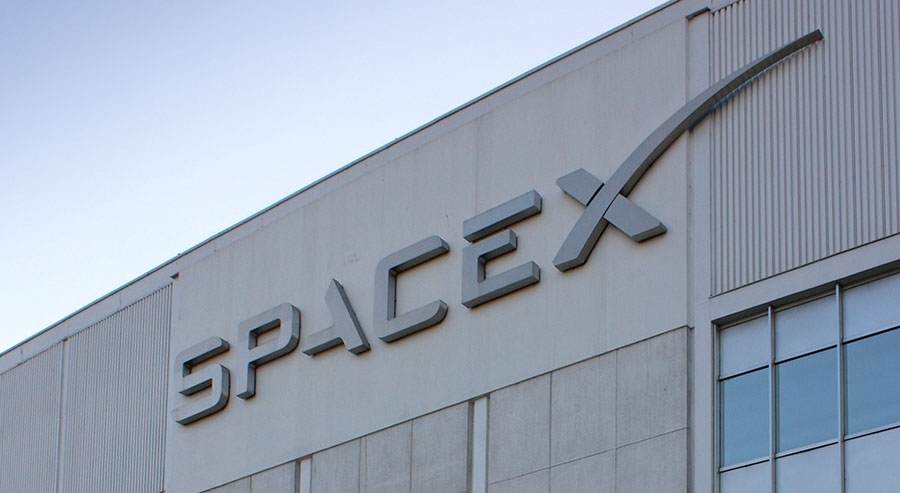
After initial failures of the newly developed rocket Falcon 1, the company within a few years developed Falcon 9 which was a success. With the first launched of Falcon Heavy in 2018, the company offers the strongest available launcher. Since the end of May 2020, SpaceX has been carrying out manned space flights, initially for NASA to the ISS, this succeeded on May 30. From 2021, space tourists are also to be launched into space.
SpaceX operates four launch facilities on the U.S. East and West Coast and the Gulf Coast of Texas. With the Starlink project for worldwide satellite Internet access, SpaceX is also the world’s largest private satellite manufacturer and operator in terms of the number of satellites.
Management
Key leaders of SpaceX are the founder and main owner Elon Musk (CEO and CTO), Gwynne Shotwell (President and COO ), Hans Koenigsmann (Vice President for Mission Security and Chief Engineer for the rocket launches ) and Lars Blackmore, Principal Rocket Landing Engineer (e.g.: Chief Engineer) for rocket landings).
History
SpaceX was founded in June 2002 by the entrepreneur Elon Musk, who had made several hundred million US dollars with the two Internet companies Zip2 and PayPal and spent a large part of it on the founding of SpaceX. At first, Elon Musk looked around for a rocket to buy in Russia for his intended Mars Oasis mission. In the end, the Russian missiles were not priced.
Aerospace
The company started developing the Falcon 1 with around 30 employees. Most parts of this rocket, such as the Merlin and Kestrel engines, were new developments. In June 2005, around 130 people were already employed by SpaceX.
After the first three flights ended in failure, the Falcon 1 successfully made its first orbit in September 2008. SpaceX is the first completely privately developed liquid fuel rocket to reach orbit.
In December 2008, a contract was signed between SpaceX and NASA for $1.6 billion for twelve supply shipments to the International Space Station. A total of 20 tons of freight are to be delivered to the ISS with Falcon 9 rockets.
After the development and demonstration flights, space flights to the ISS have been carried out by SpaceX since 2012 and satellite launches are carried out for customers such as SES SA, AsiaSat, Thaicom and Orbcomm.
In September 2014, NASA placed an order of $2.6 billion based on the manned Dragon V2 model to build the spacecraft, including a demonstration flight with two NASA astronauts. After successful flight and certification by NASA, two to six manned missions are to be commissioned. Funding is provided through the NASA Commercial Crew Transportation Capability (CCtCap) development program.
On June 28, 2015, the Falcon 9 of a Dragon supply flight exploded on its way to the ISS.
On December 22, 2015 at 1:29 UTC, an improved Falcon 9 rocket launched from the American Cape Canaveral Air Force Station into near-Earth satellite orbit. There the stage rocket shared and the second stage deployed eleven Orbcomm communications satellites. The first stage successfully accomplished the world’s first soft landing of an orbital launch vehicle at 1:40 UTC. SpaceX is the first company to safely bring the main stage of a rocket back to Earth. After the setback explosion caused by the launchpad explosion, SpaceX launched another rocket with 4 Iridium satellites on January 14, 2017.
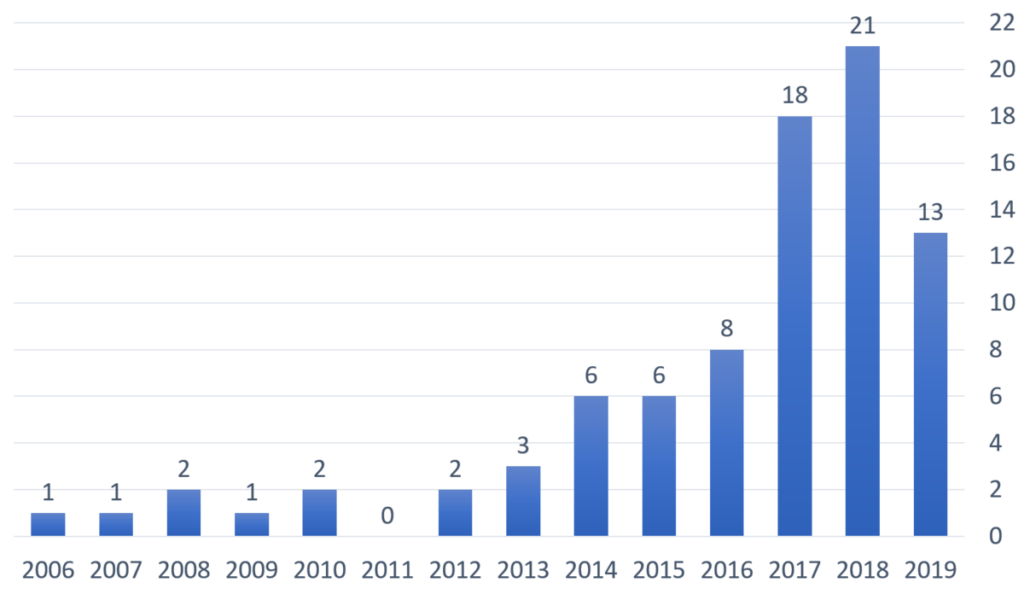
The first reuse of a first rocket stage was achieved in March 2017. A communication satellite, the SES-10, was launched from launch complex 39A into geostationary earth orbit. The first stage was used, which landed on April 8, 2016 during the CRS-8 mission as the first on the autonomous spaceport drone ship. At the start of the Falcon 9 with the SES-10 on 31 March 2017 was reused a rocket stage for the first time. After that, the first stage landed successfully on the drone ship “Of Course I Still Love You” for the second time.
On December 3rd at 18:34 UTC a further improved variant of the Vandenberg AFB with Spaceflight SSO-A from the Space Launch Complex 4E launched into the sun-synchronous earth orbit. The first stage was previously used on the Bangabandhu-1 (May 11, 2018) and Merah Putih (Telkom-4) (August 7, 2018) missions. She then landed on the autonomous spaceport drone ship “Just Read the Instructions”, which was only a few kilometers from the coast and made it the third use of an orbital rocket.
In 2014, SpaceX turned against the US military’s previous practice of awarding space flight orders exclusively to the United Launch Alliance, which consisted of Boeing and Lockheed Martin. The launch of a Falcon 9 missile as the first military order to SpaceX took place on May 1, 2017. The client was the United States National Intelligence Agency (NGO), a military intelligence service that manufactures and operates spy satellites. The name of the mission is “NROL-76”, details of the objects being launched have not been made public.
Starlink
In January 2015, the American companies Fidelity Investments and Google jointly invested around $1 billion in SpaceX. They held 8.3% of the company. It was believed that Google was interested in SpaceX’s new plan to build a network of satellites for Internet access. The execution is expected to cost $10 billion and will take approximately five years. In November 2016, the company submitted preliminary plans for such a concept with the US regulator Federal Communications Commission one. SpaceX plans to deploy 11,927 satellites in orbits 340 to 1,325 km high.
In May 2019, a Falcon 9 with 60 prototypes that do not yet have the full functionality provided was launched in orbits up to 550 km high.
Facilities
Headquarters
The company’s headquarters and extensive development and manufacturing facilities are located in Hawthorne, California. The flight control center for all SpaceX missions is also located here.
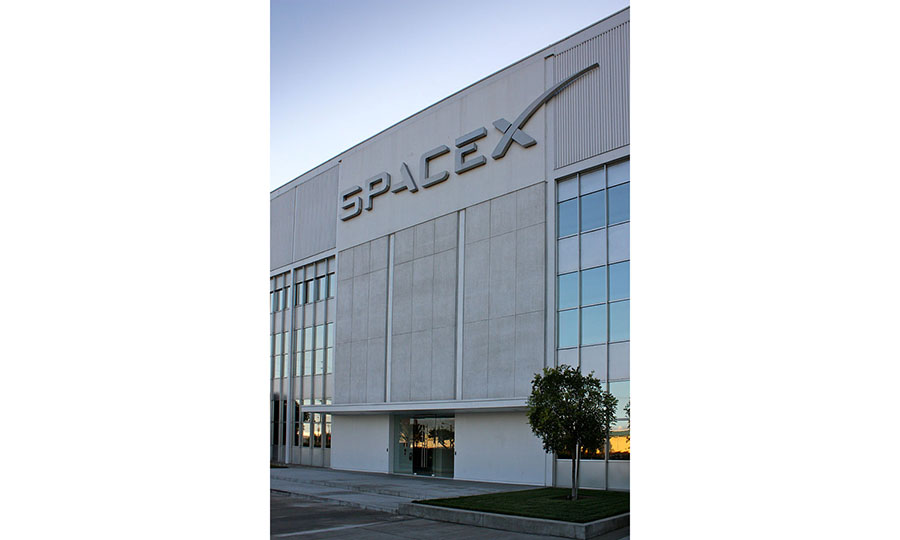
Test facilities
In McGregor, Texas, SpaceX has been operating a test facility for rocket engines and maneuvering nozzles since 2003. Much of the development work related to engine technology also takes place here.
Takeoff and landing facilities
All five Falcon 1 missiles were launched from the Kwajalein Missile Range on Omelek (Marshall Islands).
The launch of Falcon 9 rockets made either from specially modified Space Launch Complex 40 (SLC-40) of the Cape Canaveral AFS, from Launch Complex 39A (LC-39A) of the adjacent Kennedy Space Center or from Space Launch Complex 4E (SLC 4E) of Vandenberg Air Force Base in California, where the company has hangars where the delivered rocket stages are assembled before launch. The Falcon Heavy has also started on the LC-39A, for which SpaceX signed a 20-year lease in 2014. Falcon heavy starts from SLC-4E are also possible.
For the landing of the rockets (stages) launched on the east coast, SpaceX operates the Landing Complex 1 at Cape Canaveral with two landing areas. At Vandenberg Air Force Base, a landing area was built on the neighboring former Launch Complex 4W. Water landings take place on floating platforms in the Atlantic or Pacific, the Autonomous spaceport drone ships ; Payload fairings are caught with the special vessel GO Ms. Tree (formerly Mr. Steven ) or salvaged from the sea.
Near Brownsville, Texas, the SpaceX South Texas Launch Site has been under construction since 2014 as its own spaceport. Falcon racts were originally supposed to start from there from 2016. Instead, the facility is now a production and test center for the new Starship and Super Heavy rocket, which is also to fly into space from there.
Technology
Falcon 1
The first test flight of the light Falcon 1 rocket took place after multiple postponements since September 2004 on March 24, 2006, but ended with the crash of the rocket due to a fuel leak. Afterwards, a commission of inquiry set up by SpaceX and the US Department of Defense met. On the second test flight on March 21, 2007, the rocket reached a height of 300 kilometers. The second stage of the rocket collided with the outlet nozzle of the first stage when it was separated. This was probably the reason for the detachment of a stabilization ring, which caused the upper stage to tumble and out of control. According to SpaceX, the disturbed telemetry data couldlargely restored afterwards. The upper stage plunged back into the earth’s atmosphere.
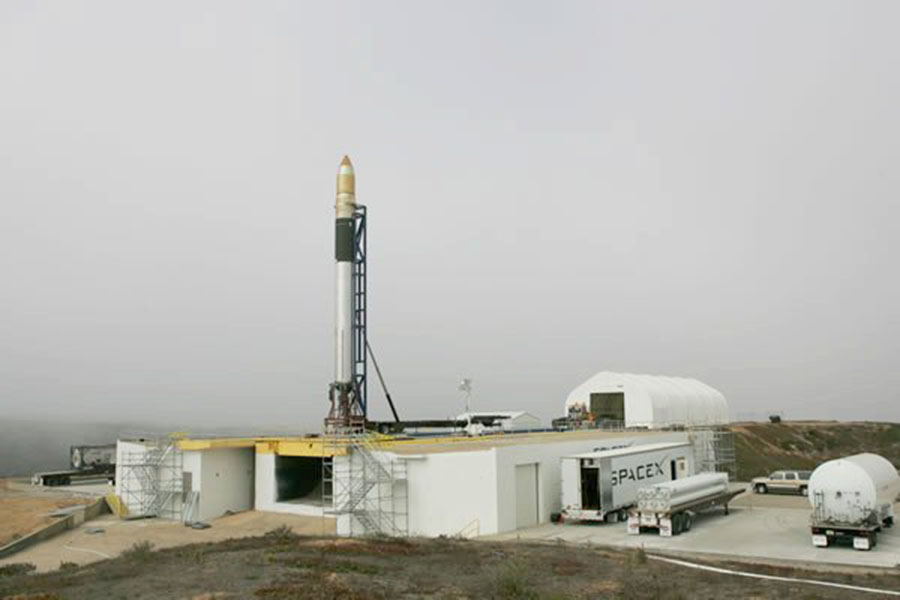
The third test flight on August 3, 2008 failed again. The launch was initially as expected, but there were problems with the stage separation and the rocket got out of control. The fourth flight on September 28, 2008 was successful. The same engine type (Merlin C) was used as in the previous flight. By correcting the step separation error, the Falcon 1 was able to suspend its 165 kg sample payload in a 644 km high orbit. On July 14, 2009, Falcon 1 was used commercially for the first time with the launch of the Malaysian satellite RazakSAT.
Falcon 5
The Falcon 5 was a planned missile based on the Falcon 1 technology. The first stage was to be powered by five Merlin engines and, like the first stage of the Falcon 1, were to be returned to earth with the help of parachutes to be reused. By using five engines, the Falcon 5 should be able to fulfill its mission even if one engine fails. The second stage would have been powered by a modified Merlin engine, which was optimized for operation in a nearly vacuum with an enlarged exhaust nozzle. The Falcon 5 should be able to transport 6,020 kg from Cape Canaveral into a 200 km orbit, which would have placed it in the performance class of the Delta II rocket.
After announcing the plans to develop the Falcon 9, SpaceX first changed the configuration of the Falcon 5. The Falcon 5 should be built from a modified first stage of the Falcon 9 and be able to carry a payload of 4,100 kg. In the course of developing the Falcon 9, the Falcon 5 was finally dispensed with.
Falcon 9
In 2006, SpaceX participated in NASA’s private supply competition, the Commercial Orbital Transportation Services program, and was one of the winners. The Falcon 9 was further developed and tested in cooperation with NASA. The maiden flight took place on June 4, 2010 and the first flight to the ISS on October 8, 2012.
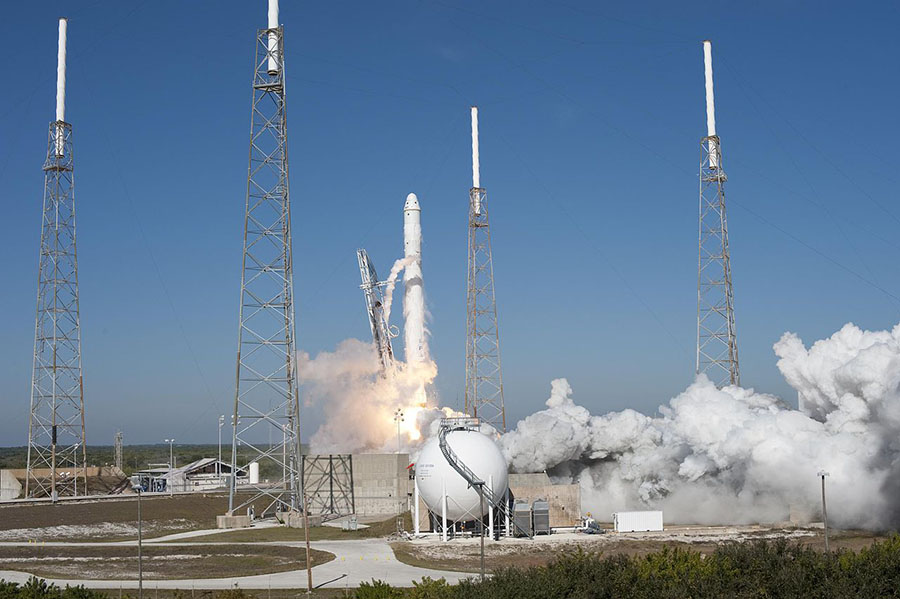
In addition to launching the Dragon capsules, the Falcon 9 is also used to launch private and government payloads. SpaceX has thus become a direct competitor of established launch providers such as International Launch Services, Arianespace and the United Launch Alliance.
Reusable rocket
The Grasshopper and the Falcon 9 Reusable Development Vehicles (F9R Dev) are experimental rockets for suborbital flights that are used to test how a rocket stage can be landed in a controlled manner after launch. The aim is to use missile components several times in order to minimize costs.
The findings flowed into modifications of the first stage of the Falcon 9 actually used, with the landing attempts being carried out first over the ocean and then on the Autonomous Spaceport Drone Ship (ASDS) for safety reasons.
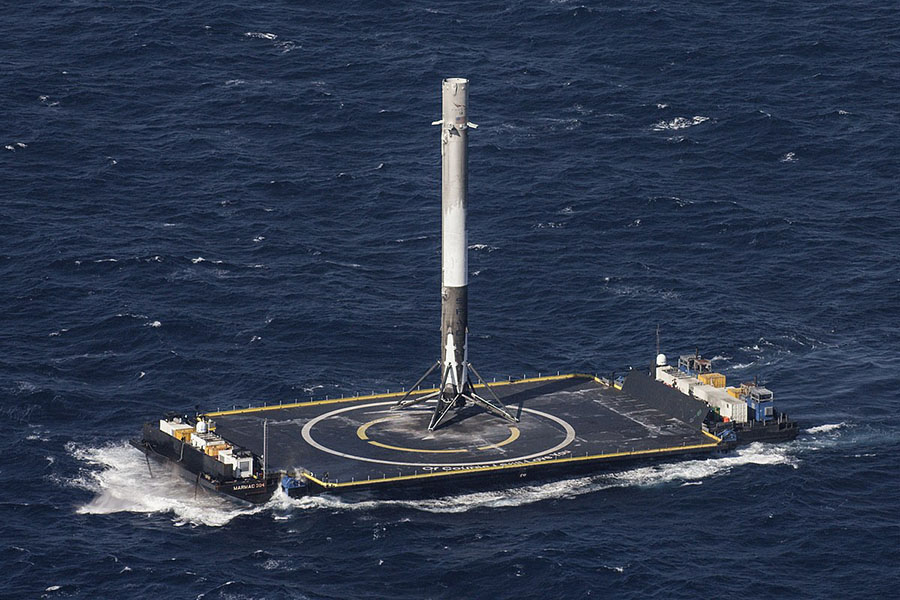
On December 21, 2015 local time (December 22, UTC) when a Falcon 9 took off for the 20th time, it was possible to return from space and land safely at the Cape Canaveral launch site. On April 8, 2016, as part of the CRS-8 mission, a first stage successfully landed on the Autonomous spaceport drone ship.
The first reused Falcon 9 first stage was launched on March 30, 2017 and landed successfully. SpaceX is also working on reusing the payload fairing.
Falcon Heavy
As early as the mid-2000s, SpaceX was planning to develop a much more powerful rocket with two boosters. The project turned out to be unexpectedly complex and was further delayed by the explosion of a Falcon 9 in September 2016.
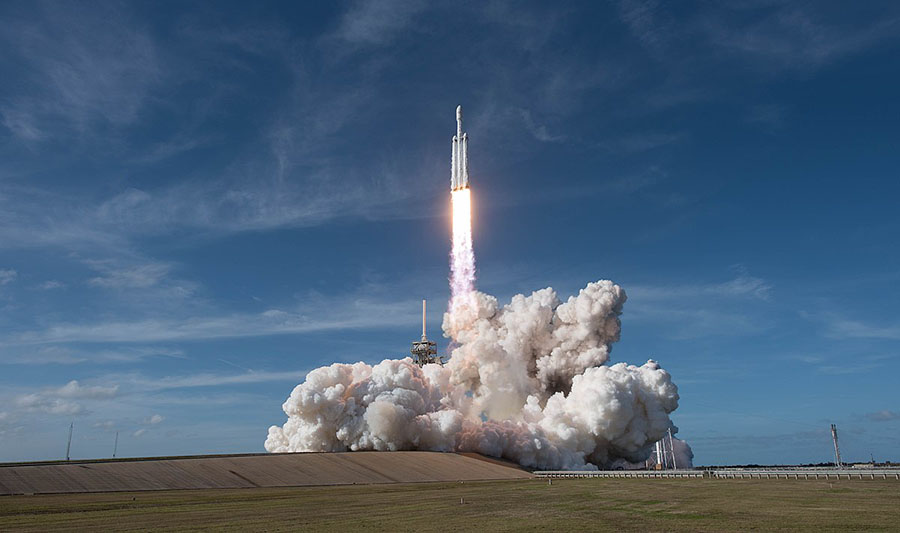
On February 6, 2018, the first flight of the Falcon Heavy took place five years late. It consists of three modified Falcon 9 first stages with a total of 27 Merlin engines and a Falcon 9 upper stage. The Falcon Heavy is currently and until the completion of the Space Launch System (expected for 2021 at the earliest) the most powerful launch vehicle available worldwide. Historically, it is the second-strongest American launch vehicle since the Saturn V moon rocket.
Dragon
The Dragon capsule was also designed, built and tested on its own, but with NASA support as part of the C3P program. On December 8, 2010, the first Dragon capsule took off on a Falcon 9 for a space flight and after about three hours it was watering in the Pacific Ocean. Thus, the ability was demonstrated, also to land the capsule. The capsule is the only cargo system capable of delivering large payloads from the ISS back to Earth. Other cargo space ships like HTV and Progress burn up in the atmosphere on their way back.
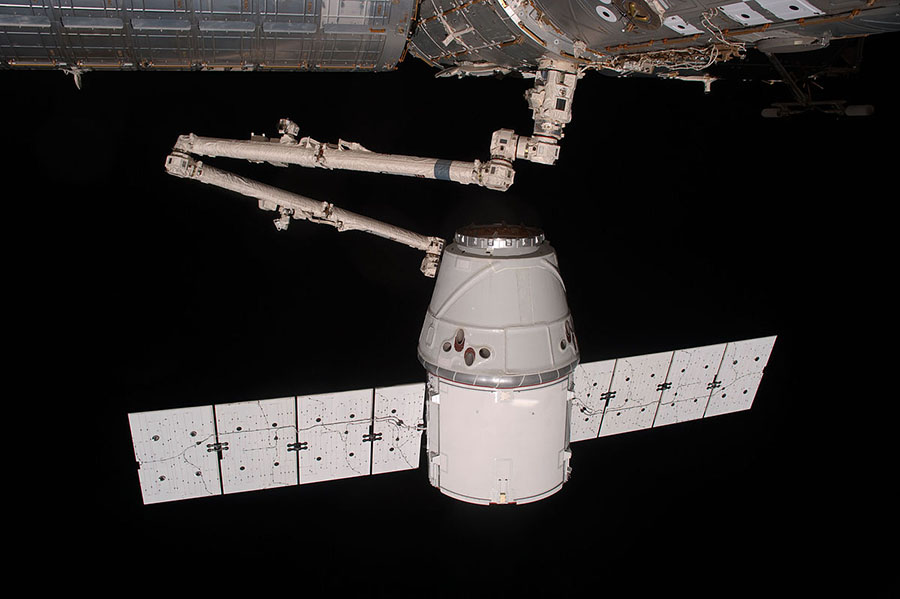
In May 2012, the first flight of a Dragon spacecraft to the ISS took place with the COTS -2 mission. The nine-day flight included numerous test maneuvers. The spaceship transported 520 kg of cargo to the ISS and landed back on earth with over 600 kg of equipment no longer required.
Regular supply flights to the ISS took place from October 2012 to March 2020. On June 28, 2015, a Dragon capsule crashed shortly after launch due to the explosion of the Falcon 9 launch vehicle due to a broken strut. 1.8 tons of freight were lost to the ISS. From the Mission CRS -13 in December 2017 to the final mission CRS-20 began SpaceX only used Dragon capsules.
Dragon 2
The Dragon 2 spacecraft will replace the Dragon from 2020. It is built in two versions: the Crew Dragon for the combined transport of space travelers and cargo and the Cargo Dragon 2 as a pure freighter. Like the previous model, the Dragon 2 is designed to be reusable in order to limit the manufacturing costs per flight.
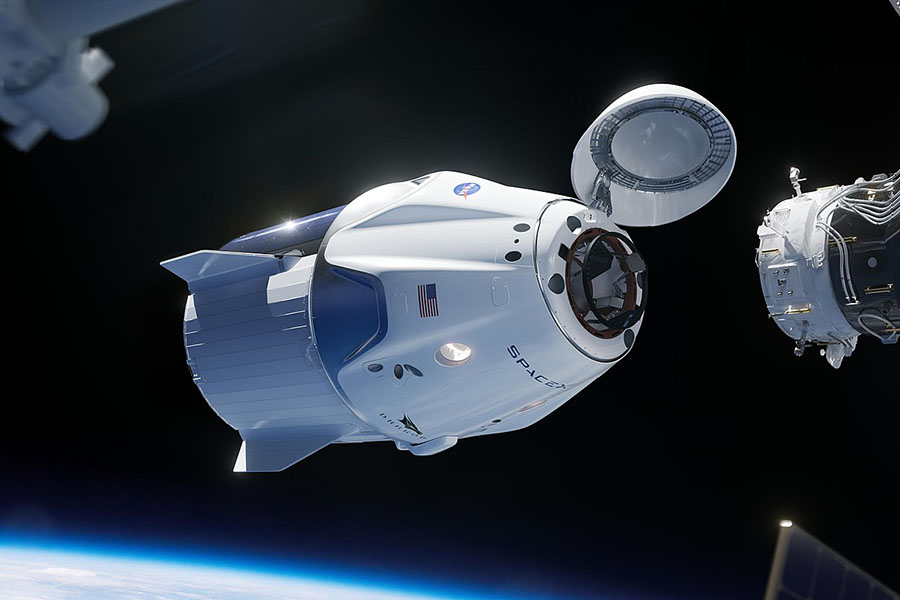
The first unmanned test mission of a Crew Dragon took place in March 2019 as Mission SpX-DM1. On May 30, 2020 at 9:22 p.m. (CEST), Crew Dragon 2 started as Mission SpX-DM2 with Douglas Hurley and Robert Behnken as crew. The first cargo Dragon 2 is expected to bring 2,020 cargo to the ISS in the fall. With this schedule, SpaceX trumped the Boeing group, whose much more expensive CST-100 Starliner space capsule will only be ready for use later due to technical defects.
Interplanetary Transport System
On September 27, 2016, SpaceX CEO Elon Musk presented plans for the Interplanetary Transport System (ITS), which was the first to enable a manned flight to Mars. The work required for this purpose at the rocket engine Raptor began in 2014. The entire ITS vehicle should have a height of 122m and 300 tons of cargo in the LEO can transport, the spacecraft having a diameter of 17m.
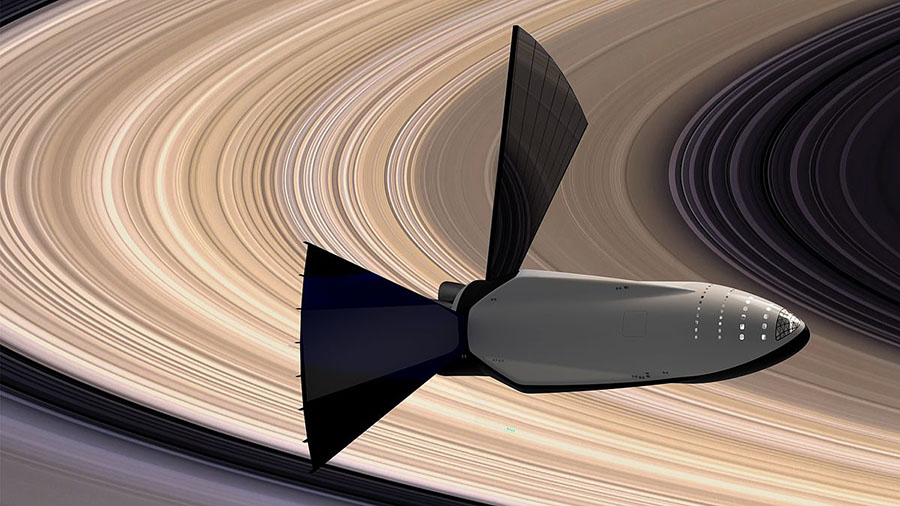
In the planned dimension, the ITS proved to be unaffordable. The concept was therefore further developed into a significantly smaller and more universally applicable BFR.
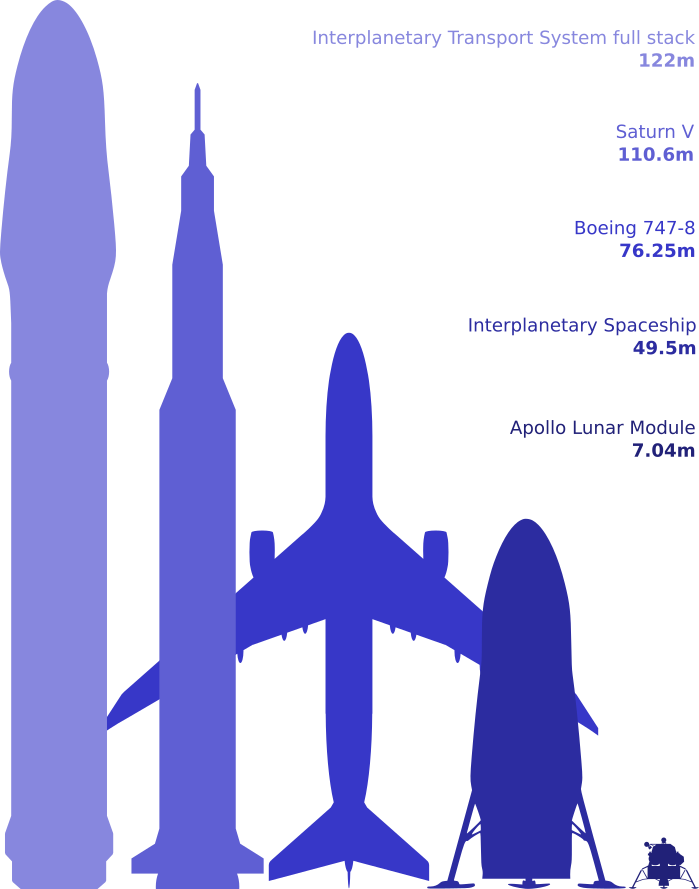
Starship and Super Heavy
On September 29, 2017, SpaceX CEO Elon Musk presented the BFR (Big Falcon Rocket; alternatively also Big Fucking Rocket), which is the first to enable a manned flight to Mars. In addition, it should be able to be used to transport satellites into orbit and to supply the International Space Station or a possible future base on the moon. In principle, it should also be able to quickly transport passengers over long distances on Earth.
The lower stage is said to be powered by 31 Raptor rocket engines, and the entire BFR is said to be over 100 meters high and nine meters in diameter.
The fully reusable variant is said to be able to transport over 100 tons of cargo into low earth orbits. After refueling several times in orbit, the same mass of cargo should be able to be transported to Mars.
The first Mars mission is scheduled to start in 2022, according to Musk’s older plans. A first manned mission is set to follow two years later to prepare for fuel production on Mars. Musk’s previous schedules mostly turned out to be too optimistic; there were regular delays of several years. In May 2020, SpaceX removed the 2022 and 2024 target dates from the Starship description on the company’s website.
On September 17, 2018, Musk announced that the BFR would bring a paying tourist to the moon and back for the first time in 2023: the Japanese billionaire Yusaku Maezawa.
Dragon XL
In March 2020, SpaceX received an order from NASA to develop the Dragon XL, an enlarged version of the Cargo Dragon 2 cargo ship. It should supply the lunar orbital platform gateway with up to 5 tons of freight per flight at the earliest from the mid-2020s. The Falcon Heavy is to be used as the launch vehicle.









